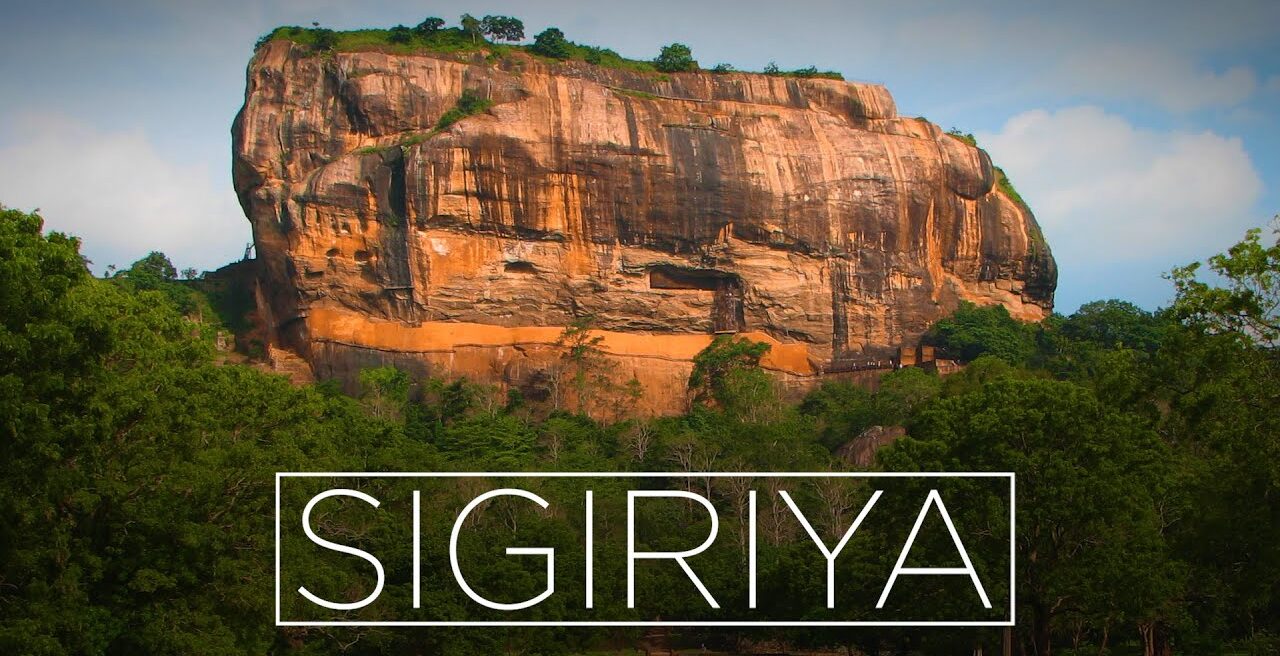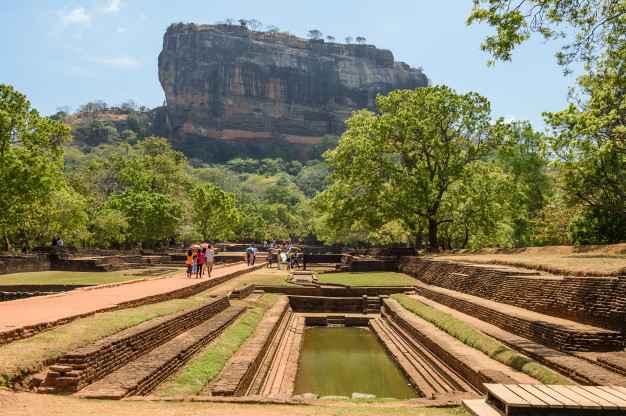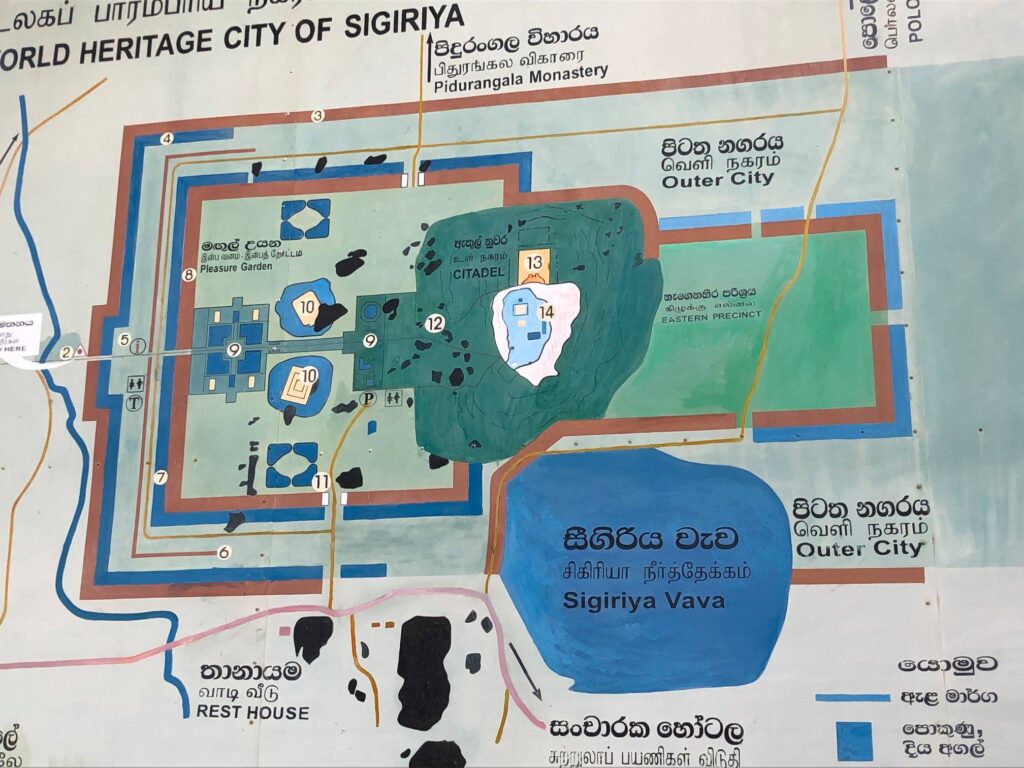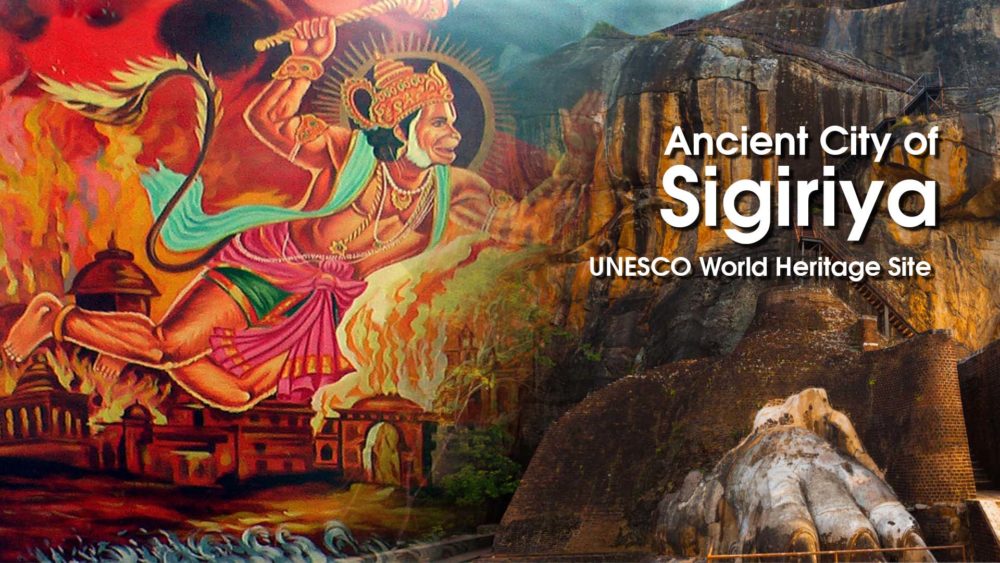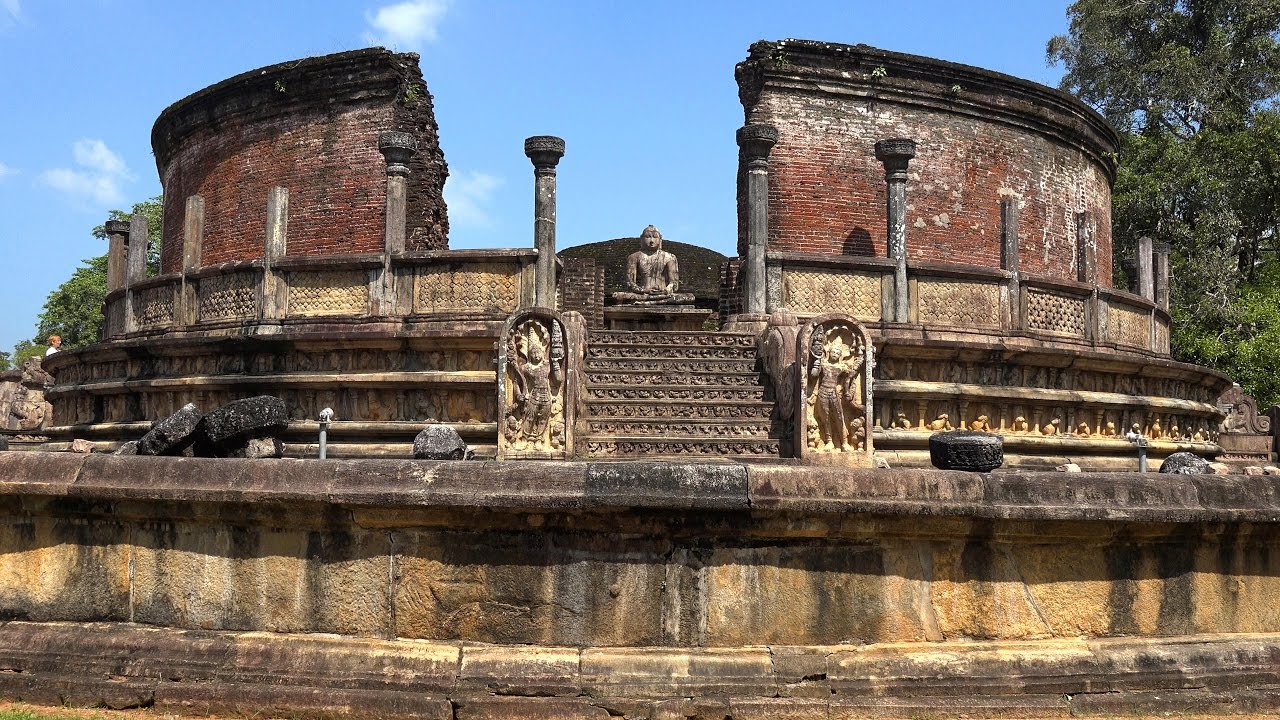Sigiriya is an ancient rock fort and palace built by King Kashyapa during the reign of 473 – 495 that stands 660 feet straight up. It is located in the North Matale District near the city of Dambulla in the Central Province of Sri Lanka. The word Sigiriya or Sinhagiri means Lion’s Rock where you have to climb 1200 steps before reaching the Lion Rock Fort at the top of Sigiriya. There are a number of platforms that break down the steps and add a little pause when needed. Today the Sigiriya Rock Fort is one of the most famous archeological treasures and UNESCO designated the Sigiriya Rock as a World Heritage Site in 1982 with the name “Ancient City of Sigiriya Sri Lanka”.
The Architecture of Sigiriya Lion Rock
This fortified garden city of Sigiriya Rock Fort is an exceptional masterpiece of ancient urban planning / landscape and architecture / construction technology / exceptional hydraulic engineering and management / ancient fine art with unique harmony between nature and human imagination and all these surviving examples have Proved that it was a well-planned city and palace in the 5th century AD. Sigiriya Rock Fort is considered one of the best preserved surviving ancient urban sites in Asia from the first millennium or simply a living museum. The Sigiriya World Heritage Site has multifaceted and multifaceted appeal, and is one of the ancient political capitals of Sri Lanka and one of Sri Lanka’s most sensational heritage sites.
History of Sigiriya Rock Fortress
Historical research at the site suggests that Sigiriya has its origins in pre-historic times. Located at the base of the Sigiriya rock on its eastern side, there is a monastery called Aligala (Elephant Rock). Excavations in a cave beneath it have yielded the remains of pre-historic human settlements dating back to about 5,500 years BP. In addition, there is evidence of human habitation in the area, which dates back to the 9th – 10th centuries BC in history.
3rd century BC A Buddhist monastery was established in the Sigiriya Rock Fort in AD. So far thirty cave-shelters have been identified at the base of the great rock with drip-ledges to accommodate monks. Of these, the details of donation of cave shelters in eight are inscribed in Brahmi script.
All the major structures, found today in Sigiriya, were built during the reign of King Kashyapa (AD 477 – 495), who chose Sigiriya to be his seat of administration. According to eminent archaeologist Prof: Senerath Parnavithan, Sigiriya depicts the sensuality of a pleasure-loving king, who built the city on the mythical Alkamanda of Lord Kuvera. Indian and Roman coins and pottery belonging to the Sassanian dynasty of Persia (Iran) found at the Sigiriya Rock Fort, as well as Persian styles in the construction of pleasure gardens, all had commercial and cultural relations with foreign countries during this brief period. indicate.
Sigiriya Lion Rock Fortress in 7th Century AD
After this, however, in the 6th and 7th centuries AD, Sigiriya ceased to be of political importance and once again became the residence of Buddhist monks. During this period, the drip-led cave-shelters that belonged to the earlier monastic phase were further improved. Additional temples such as Stupa, Chavi Ghar and Bodhi Vriksha Temple were built. This second phase of monastic development continued until the 12th – 13th centuries AD.
19th Century Sigiriya Rock
In the centuries that followed, Sigiriya was completely abandoned until the 19th century, when it was used as a military out-post for the kings of Kandy. Later, it was a British army. In 1832 the officer, Jonathan Forbes, who once again brought Sigiriya out of its obscurity, brought it back to historical attention. In 1894 H.C.P. The Bel Archaeological Department initiated archaeological activities in Sigiriya. Almost a century later, in 1982, the Central Cultural Fund took over, which continues with great success to this day.
City Planning of Sigiriya Rock – World Heritage
The Lion Rock Sigiriya consists of two fortified areas, with the western boundary extending over 90 ha, and the eastern boundary extending over 40 ha. The western area was the royal park area, a symmetrically designed pleasure garden with elaborate water-holding structures, as well as surface and subsurface hydraulic systems. It is surrounded by three ramparts and two moats, forming a rectangular area with an internal boundary of about 700 meters from east to west and 500 meters from north to south.
On the other side of the Lion Rock Sigiriya, the eastern area appears to be a formal complex with a large central pavilion as its only permanent structure. Kashyap and his royal family lived their lives within these walls. Moving inward from the two complexes in an ever-increasing fashion are a series of boulder gardens and then terraced gardens, leading to the entrance to the Sigiriya cliff. Access to the cliff is achieved through a long route that begins on the west side of the terrace gardens, and winds along the north side Mirror Wall to the Lion Platform.
Water Garden & Landscape gardening of Lion rock Sigiriya
The Water Gardens are particularly notable among the important features of Sigiriya. Although outwardly the water garden appears to be a garden system in concept, four distinct parts can be clearly seen in its construction, and are currently called water gardens numbers 1, 2 and 3 and miniature water gardens. .
The water garden number l has four large ‘L’ shaped ponds arranged symmetrically forming an island in the middle. This is considered a special feature found in ancient garden designs and is referred to as the “char-garden” and the specimen in Water Garden No. 1 appears to be one of the oldest in the world today. Water Garden No. 2 has fountains, and hence it is also called Fountain Garden. There are two summer palaces on either side of this fountain garden.
Visitors will be amazed at how the fountain was fed with water. The answer lies in the moats built around summer palaces, connected by hidden underground channels that feed. D. Fountains dry easily unobtrusively. Water Garden No. 3 is located at a high altitude and has an asymmetrical layout, here the balance and symmetry of the other sections of the garden system are absent. The Miniature Water Garden is a ‘miniature’ refinement of the other three garden systems, a kind of micro-scale-die model of the aggregate concept. The inter-relationship, ‘symmetry and integration between the different parts of the water garden and the overall balance. Achieving thus far is indeed a win.
Lion Rock Sigiriya Graffiti
Highlights of the Sigiriya rock are the Sigiri frescoes, the Lion’s Claw entrance, the Boulder Garden, the Mirror Wall, fresco paintings of female figures, the extensive network of landscape gardens, the Water Garden, moats, ramparts and the remains of the palace.
The lion rock Sigiriya frescoes were written on the surface of the mirror wall in Sigiriya. On the wall are more than 1800 pieces of prose, poetry and commentary written by ancient tourists. These frescoes provide a fascinating insight into the history of Sigiriya and the development of the language in Sri Lanka over a period of 800 years.
Most of the frescoes refer to beautiful portraits of semi-nude women. These frescoes confirm that this site was the residence of King Kashyapa, who ruled from 477 to 495 AD. The texts also show that the women depicted in the frescoes are the women of the royal court of the king – the women of the harem.
The frescoes include statements of astonishment, declarations of love, remarks, curses, lamentations, diary entries, or simply travel statements.
Many display a high level of literacy and a deep appreciation of art and poetry written in Sinhalese, Sanskrit and Tamil. These early scribblers have left us invaluable insight into the past. Of these images so far 685 individuals have been identified, 12 were women, more than half identified themselves by name, many mentioned their social rank, and some also mentioned that they were from Weligama and Sri Lanka. Where did cities like Ritigala come from? It seems that the majority of these visitors are from the elite of society: royalty, officials, professions and clergy. There were soldiers, archers and even metal workers. Over 1000 unique words have been identified.
Boulder Garden of Lion Rock Sigiriya
Boulder Gardens has a sloping area around a central rock that is dotted with boulders of various sizes. On the rock summit the routes to the palace are laid out as winding routes through the Boulder Gardens which are punctuated by natural boulder arches. Unique features of the park include the cistern rock that derives its name from a large pool made of natural boulders and large granite slabs, the ‘audience hall’, where a five-metre-tall main throne is carved out of living rock, ‘Preaching Rock’ where a seat is carved into the flat edge of a fairly high boulder, and ‘Asan Cave’ where a seat is carved inside a natural cave. Sigiriya was a Buddhist monastery, rock caves with drip-ledges and temples used during that time can also be seen in the area. The Terraced Garden of Sigiriya Lion Rock is situated on a high ground between Boulder Garden and Sigiriya Rock and is built into a series of steeply pitched terraces through stone retaining walls.
Lion Staircase
The final ascent of the royal palace atop the Sigiriya rock is via the Lion Ladder, which faces north and a lion has two huge claws in front. These lion-paws, made of brick and covered with plaster, are the remains of a façade of a lion figure that may have once stood there.
Palace Complex of Sigiriya Lion Rock
The Palace complex on top of the Sigiriya rock is about 1.5 hectares. The major monument to be seen there is the royal palace which is situated on the west side. The garden of the palace which includes a large artificial pool and. Other garden features are located to the east. Below the palace, on a cliff on the east side, there is a throne made of natural rock.
Lion Rock Paintings
The paintings of the fifth century AD are unquestionably the culmination of all Sri Lankan artistic creations. Found in a depression on the western edge of the rock-face, these images, numbering nineteen, are the figures of exquisite girls floating among the clouds. According to the Sigiri frescoes (verses on the mirror wall from the ages), however, there were originally five hundred such figures painted throughout the western and northern rock-faces.
Several theories attempt to explain. The hallmarks of the beautiful women depicted in these ancient works. hcp According to Bell, she is Kashyapa’s mistress, carrying flowers to offer, to worship at the nearby Pidurangala temple. According to the eminent scholar Ananda Konomaraswamy, the girls are Apsaras or goddesses. Eminent Sri Lankan archaeologist.
Pro. Senerat Paranvitana offers a very original interpretation of the identity of the girls of Sigiriya, which maintains that the maiden are symbolic representations of rain-clouds and lightning. According to this interpretation, black girls (Meghalta) symbolize rain clouds and fair golden skin, while Vajji Kumari was a symbol of lightning. Apart from these paintings, there are also paintings in the caves of Boulder Garden. Deraniyagala Cave, Cobra-hood Cave and Asan show clear traces of cave paintings.
In addition, recently it has been discovered that the drawings were made on the outer surface of the mirror wall. Although all these paintings have faded, a female figure can be seen floating among the clouds.
Terracotta figurines are very similar to tyre figures. The paintings have been discovered in Sigiriya during archeological excavations. Leading the major archeological projects in Sigiriya, Prof. According to Senaka Bandaranaike, these may be replicas of Sigiriya dams sold to visitors as souvenirs in the past.
How is the Sigiriya related Ramayana Trail, Sri Lanka?
The Cobra Hood Cave, also known as “Parumaka Nagulia Lena”, is a natural geological formation that has been characterized as a cobra hood located within the Boulder Gardens of the Sigiriya Rock Fort complex, which once housed flowers and animals. The interior of the cave is decorated with paintings. It is also part of the Sigiriya Rock Fort Complex (UNESCO World Heritage).
According to the recent discovery of Ramayana in Lanka Pura by Sri Lal Srinivas and Dr Mirando Obesekara, Sigiriya can be considered as a later turning point of the historical archeology of King Ravana. According to him, Sigiriya may have been the Alkamandava or the City of the Gods built 50 centuries ago by King Kuvera who was the half-brother of King Ravana as defined in the Ramayana journey Sri Lanka.
According to the Palm Leaf Book (Puskola Potha) of Ravana Vatha (Ravana Katha), the architect of Sigiriya was a demon named Maya Danava. He built Sigiriya on the instructions of King Vishwavas (Vishvasamuni), father of Ravana. During that period Sigiriya was called Alakmandava and during the period of King Kuvera it was called Chitrankoot. After the death of Ravana, Vibhishana became the king and transferred the kingdom to Kelaniya.
Man-made drip ledge and Brahmi inscription of 3rd century BC. The association with this cave indicates that the cave may have served as a Buddhist monastery/residence of monks. The paintings on the rock ceiling have floral and stylized animal motifs with geometric composition. The brick paved floor of the cave is made of lime plaster. The boulder attached to the cave has been cut from the mother boulder and looks like a cobra’s hood. The fallen piece of boulder can still be seen in front of the cave.
Therefore historians consider Sigiriya to be related to Ramayana. It is believed that the top of the plateau was the site of Ravana’s majestic palace, which, about 50 centuries ago, was made of solid gold and sculpted by Kubera, the god of wealth. Take a look at the site, and you will realize what a great architectural achievement this place must have been. As it is believed, one of these caves is where King Ravana kidnapped Princess Sita after she was imprisoned.
Skeleton discovered in Cobra Hood Cave Sigiriya
Archaeological excavations in the cave/rock shelter have led to the discovery of nine human skeletons. The excavations at the Sigiriya Cobra Hood Cave have led to what appears to be a burial site of the Middle Historical period. Skeletons of nine people were found from the excavation. This study suggests that these individuals were young healthy adult males of 152 cm or more in height at the time of death. The practice of burial in the west-east direction has been in an extended position, with hands facing forward and facing south. No burial offerings or other ritual objects were found.
Good Read – Galle, Sri Lanka
Frequently Asked Questions About Sigiriya
Q. Why is Sigiriya famous?
A – Sigiriya is a best preserved ancient rock fort and one of the archaeological treasures in South Asia. It is a masterpiece of ancient urban planning / landscape and architecture / construction technology / exceptional hydraulic engineering and management / ancient fine arts with unique harmony between nature and human imagination. Thus UNESCO declared this site as World Heritage.
Q. Who built the Sigiriya rock?
A – Sri Lankan king Kashyapa built the famous Sigiriya lion rock
Q. How many stairs are there to climb Lion Rock Sigiriya?
A – There are about 1,200 steps to climb to the summit.
Q. What is the height of Singh Rock Sigiriya?
A – It is at a distance of 660 feet from the surrounding ground
Q. Lion’s Rock Climbing Sigiriya Difficult or Dangerous?
A – There’s no danger in climbing, but make sure you’re healthy enough to climb 1,200.
Q. Can senior citizens climb Sigiriya Singh Rock Fort?
A – Yes people do and you can take the time and climb. There are places for you to relax and climb. We suggest you board the senior citizen at a nearby restaurant. Also you can allow them to visit Sigiriya Museum near the main gate.
Q. Can I climb Lion’s Rock with my baby or toddler?
A – Not recommended but people climb with children 8 Y and over.
Q. Sigiriya Lion Rock opening hours for visitors?
A – 7.00 am to 5.00 pm
Q. Entrance fee for Lion Rock Sigiriya
A – USD 30 per person / foreign
USD 15 per person for nationals of SAARC countries only (passport is required to be submitted to get this exemption)
Q. What is the best time to climb Sigiriya Lion Rock?
A – Ideally at 8 – 10 am or 3 – 5 pm to avoid strong sunlight
Q. What is the temperature of Sigiriya Singh Rock?
A – about 27 – 30 C
Q. Can I buy Sigiriya Lion Rock entrance fee ticket online?
A – Not now, but it will be online soon
Q. What is the dress code for Sigiriya Lion Rock?
A – Sigiriya is not a temple or a religious place and you can wear your own attire.




